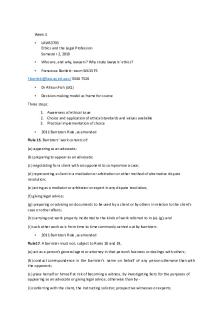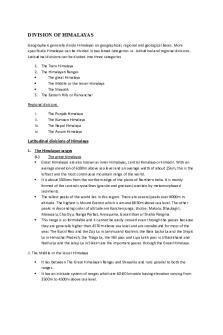Division OF Himalayas - Summary of the lecture given by Dr. R.B. Singh (Vice President, International PDF

| Title | Division OF Himalayas - Summary of the lecture given by Dr. R.B. Singh (Vice President, International |
|---|---|
| Course | Geography |
| Institution | University of Delhi |
| Pages | 5 |
| File Size | 233.2 KB |
| File Type | |
| Total Downloads | 56 |
| Total Views | 144 |
Summary
Summary of the lecture given by Dr. R.B. Singh (Vice President, International Geographical Union) on Division OF Himalayas at Delhi School of Economics, University of Delhi....
Description
DIVISION OF HIMALAYAS Geographers generally divide Himalayas on geographical, regional and geological bases. More specifically Himalayas can be divided in two broad categories i.e. latitudinal and regional divisions. Latitudinal divisions can be divided into three categories 1. The Trans Himalaya 2. The Himalayan Ranges The great Himalaya The Middle or the lesser Himalaya The Shiwalik 3. The Eastern Hills or Purvanchal Regional divisions i. ii. iii. iv.
The Punjab Himalaya The Kumaon Himalaya The Nepal Himalaya The Assam Himalaya
Latitudinal divisions of Himalaya 1. The Himalayan ranges (i.) The great himalayas Great Himalayas are also known as inner Himalayas, central Himalaya or Himadri. With an average elevation of 6100m above sea level and an average width of about 25km, this is the loftiest and the most continuous mountain range of the world. It is about 150kms from the northern edge of the plains of Northern India. It is mainly formed of the central crystallines (granite and gneisses) overlain by metamorphosed sediments. The tallest peaks of the world lies in this region. There are several peaks over 8000m in altitude. The highest is Mount Everest which is around 8850m above sea level. The other peaks in descending order of altitude are Kanchenjunga, Lhotse, Makalu, Dhaulagiri, Manasalu, Cho Oyu, Nanga Parbat, Annapurna, Gosainthan or Shisha Pangma. This range is so formidable and it cannot be easily crossed even through the passes because they are generally higher than 4570m above sea level and are snowbound for most of the year. The Burzil Pass and the Zoji La in Jammu and Kashmir, the Bara Lacha La and the Shipki La in Himachal Pradesh, the Thaga La, the Niti pass and Lipu Lekh pass in Uttarakhand and Nathu La and the Jelep La in Sikkim are the important passes through the Great Himalaya. ii. The Middle or the lesser Himalaya
It lies between The Great Himalayan Ranges and Shiwaliks and runs parallel to both the ranges. It has an intricate system of ranges which are 60-80 km wide having elevation varying from 3500m to 4500m above sea level.
The Prominent ranges in this are Pir Panjal, Dhaula Dhar and Mahabharata ranges.It compresses of many famous hill stations like Shimla, Dalhousie Darjeeling, Chakrata, Mussoorie, Nanital etc. It also comprises of famous valleys like Kashmir, Kullu, Kangra etc.
iii. The shiwaliks
It is the outer most range of the Himalayas. The altitude varies between 900-1100 meters and the width lies between 10-50 KM . They have low hills like Jammu Hills, etc. The valleys lying between Siwalik and Lesser Himalayas (Himachal) are called ‘Duns’ like Dehra Dun, Kotli Dun and Patli Dun.
(2. )The Trans Himalaya
The Himalayan Ranges immediately north of the Great Himalayan range are called the trans Himalayas. The most of the part of this Himalayas lies in Tibet therefore also known as Tibet Himlayas. The Zaskar, the Ladakh, the Kailas, and the Karakoram are the main ranges of the TransHimalaya system. It stretches for a distance of about 1000km in east west direction and its average elevation is 3000m above mean sea level. The average width of this region is 40km at the eastern and western extremities and about 225km in the central part. K2 (8611 m)is the second highest peak in the world and the highest peak in the Indian Union and rises majestically like a cone
(3.) The Eastern Hills or Purvanchal
The Himalayas bend sharply to the south beyond the Dihang gorge and move outwards to form a covering the eastern boundary of the country. They are known as ‘the Eastern or Purvanchal Hills’. It extended in the north-eastern states of India. Most of these hills are extended along the border of India and Myanmar while others are inside India namely- the Patkai Bum Hills, the Naga Hills and the Mizo Hills. In north it is the Patkai Bum which forms the international boundary between Arunachal Pradesh and Myanmar. After running some distance southwards it merges into Naga hills where Saramati (3,826m) is the highest peak and also the highest peak of Purvanchal ranges.
The extension of the Purvanchal Himalaya continues southwards upto Andaman and Nicobar Islands through the Myanmar range (Arakan Yoma) and even upto the Indonesian archipelago.
Regional Division of Himalayas Sir Sydney burrard divided the entire length of the Himalayas into the following four divisions on the basis of the river valleys : (1.) The Punjab Himalayas
The 560km long stretch of the Himalayas between the Indus and the Satluj rivers is known as the Punjab Himalayas. A large portion of this sector lies in Jammu and Kashmir and Himachal Pradesh as a result of which it is also called the Kashmir and Himachal Himalaya. Karakoram, Ladakh, Pir Panjal, Zaskar and Dhaola Dhar are the main ranges of this section. The 3444 metre high Zoji La pass provides an easy passage. In between the main ranges, there are valleys, duns and lakes. The general elevation falls westwards.
(2.) The Kumaon Himalayas
Between the Satluj and the Kali rivers the 320km long Kumaon Himalayas. Its western part is known as Garhwal Himalaya while the eastern part is known as Kumaon Himalaya proper.
The general elevation is compared to Punjab Himalayas.
Nanda devi (7817m), Kamet(7,176m), Trisul(7,140m), Badrinath(7,138m), Kedarnath(6968m), Gangotri(6,510m) are important peaks.
The source of sacred rivers like the Ganga and the Yamuna are located in the Kumaon Himalaya. There are several duns between the Middle Himalayas and the Shiwalik hills. Nainital and Bhimtal are important lakes. (3.) The Nepal Himalayas
This section of the Himalayas stretches for a distance of 800 km between the Kali and Tista rivers. Most of it lies in Nepal as a result of which it is called as Nepal Himalayas. This is the tallest section of the Himalayas and is crowned by several by several peaks of perpetual snow. The Mount Everest (8,850m) is the tallest peak of the world.the other major peaks are Kanchenjunga(8,850m), Lhotse I(8,501m), Makalu(8,481m), Dhaula Giri(8,172m), Cho Oyu(8,153m), and Annapurna(8,078m). Kathmandu is a famous valley in this region (4.) The Assam HImalayas
The Himalayas ranges from Tista to Brahmputra rivers covering a distance of 750km are called the Assam Himalayas. This part of the Himalayas spreads over the large parts of the Sikkim, Assam and Arunachal Pradesh and has elevation much lesser than that of the Nepal Himalayas. The southern slopes are very steep but the Northern slopes are gentle. The Lesser Himalayas are very narrow and very close to the Great Himalayas. The important peaks of this region are Namcha Barwa (7,756m), Kulu Kangri(7,554m) and Chomo Lhari(7,327m)....
Similar Free PDFs

Summary of Lecture 5
- 6 Pages

THE Sources OF International LAW
- 9 Pages

ACS - Summary of lecture
- 8 Pages

Summary of lecture notes
- 4 Pages
Popular Institutions
- Tinajero National High School - Annex
- Politeknik Caltex Riau
- Yokohama City University
- SGT University
- University of Al-Qadisiyah
- Divine Word College of Vigan
- Techniek College Rotterdam
- Universidade de Santiago
- Universiti Teknologi MARA Cawangan Johor Kampus Pasir Gudang
- Poltekkes Kemenkes Yogyakarta
- Baguio City National High School
- Colegio san marcos
- preparatoria uno
- Centro de Bachillerato Tecnológico Industrial y de Servicios No. 107
- Dalian Maritime University
- Quang Trung Secondary School
- Colegio Tecnológico en Informática
- Corporación Regional de Educación Superior
- Grupo CEDVA
- Dar Al Uloom University
- Centro de Estudios Preuniversitarios de la Universidad Nacional de Ingeniería
- 上智大学
- Aakash International School, Nuna Majara
- San Felipe Neri Catholic School
- Kang Chiao International School - New Taipei City
- Misamis Occidental National High School
- Institución Educativa Escuela Normal Juan Ladrilleros
- Kolehiyo ng Pantukan
- Batanes State College
- Instituto Continental
- Sekolah Menengah Kejuruan Kesehatan Kaltara (Tarakan)
- Colegio de La Inmaculada Concepcion - Cebu











